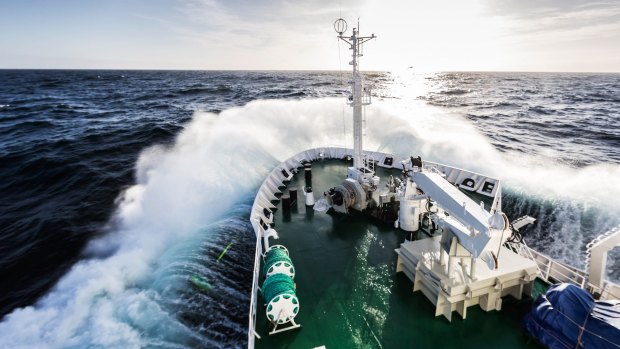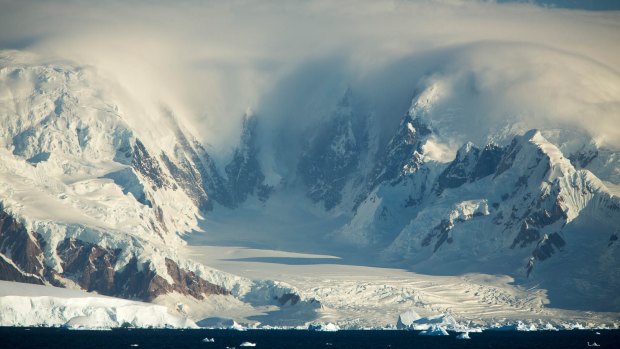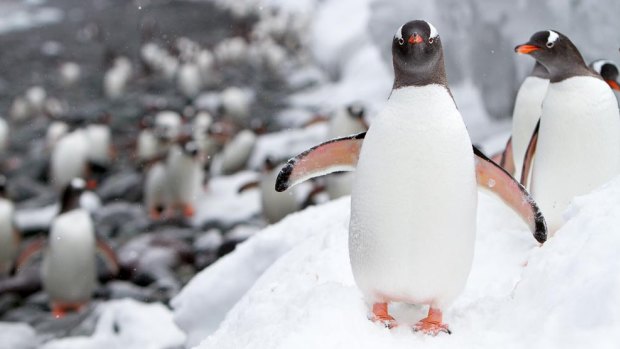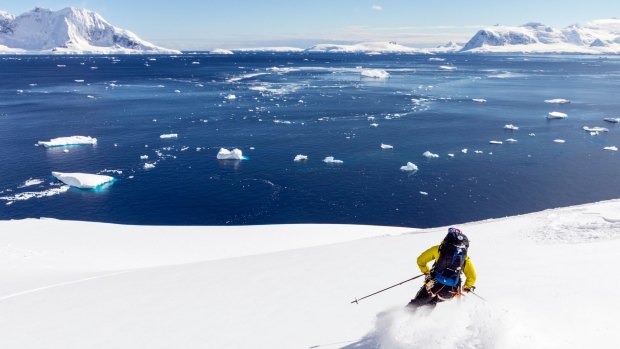This was published 6 years ago
Antarctica ski holidays: The unlikely destination that should be on every skier's bucket list
By Jim Darby

Akademic Vavilov crossing the Drake Passage.Credit: Boomer Jerritt
Backpack strapped tight. Check. Goggles clear. Check. Boots and bindings set to downhill mode. Check. Pockets zipped (you get so many with ski gear, after all). Skis ready to run. Check, check, check.
How's the snow? Looks light and predictable and there's not a track in sight. Here goes: my skis are running now and it's like hovering over silk. Ankle-deep, light, dry, powder snow has fallen overnight and settled on a slope as smooth as an Opera House sail.
There's a light breeze on my face, the sun is over my shoulder and I'm sweeping wide turns across the slope, controlling the momentum gravity gives me with long arcs through the fresh snow. I'm spending that momentum carefully, for my climbing earned me every one of these turns. My skis find their rhythm and take me to that other world where skiing normally takes me – everyday thoughts abandoned, head clear, big grin.

The Antarctic landscape.Credit: Gabe Rogel
But hang on. Something is not quite right. In fact, fairly other-worldly. Visibility is unlimited, but there's isn't a tree to be seen. Anywhere. Way above me is a vast, black rocky peak, so steep it can't hold snow. Look another way and a broad sweep of snow reaches for a ridge capped by a cornice, a treacherous lip of ice the size of a city bridge.
Far off to my left is an unnamed glacier, making its eternal march to the sea, where the icebergs it calved are bobbing around like yachts in a Wednesday afternoon regatta. No yacht clubs hereabouts though. No ski lifts or ski resorts either.
This is Antarctica and we're ski touring the last frontier.

Gentoo penguins.Credit: Ira Meyer
And there, in front of me are a couple of my mountain guides and some of my fellow ski tourers. "That first bit was a good wee grind, eh Jim?"
That's Sean Brooks, our lead guide, and that's Kiwi guide-speak for fairly hard climbing over an extended period. And it was a bit of work, but your breath won't be the only thing you'll occasionally struggle for when ski touring in Antarctica. You'll also struggle to absorb the surroundings. You have to see it to believe it, but even upon seeing it, you can't believe it. Scale is always different in the mountains, but here it goes up a level, or twenty.
The Akademik Ioffe, the hardy expedition ship that is our current home, is a few kilometres away, holding its position off the Antarctic Peninsula in the Gerlache Strait, but it might as well be a toy in a giant's ice bath, the sea ice scattered around it like pieces of an unsolved jigsaw puzzle. We've left the ship in a Zodiac inflatable just a few hours ago, raiding this wilderness like commandos, although a little more conspicuous in dress and approach.

The terrain for ski touring is virtually unlimited in Antarctica.Credit: Alamy
Soon, after a three-hour uphill tour and a 20-minute run back to the shore, we'll be back in the Zodiac and back on board for lunch. There's a delightful rhythm to the ski touring around here.
THERE AND BACK AGAIN
The Antarctic Peninsula is like an arm reaching up the globe from its mysterious depths, with South America reaching down to try and grasp it. The closer you're able to get by air to the peninsula, the quicker the crossing by sea.
Our departure point is Ushuaia, the world's southern-most city, a weather-beaten port and navy town on the tip of Tierra del Fuego that does very good business out of the growing Antarctic cruise industry.
The International Association of Antarctica Tour Operators estimates just over 44,000 people visited Antarctica last season and expect that to climb over 46,000 in 2017-18. More than 90 per cent of the tourists come, like me, by ship.
Far from an invasion, IAATO argues that tourism is a driving force in Antarctic conservation. "First-hand travel experiences lead to a better understanding of the destination, the need for responsible tourism and, ultimately, continued protection," they say.
IAATO also helps spread the load, with only one cruise in an area at any one time and a set of guidelines their members abide by to preserve this pristine wilderness: take nothing, leave nothing, and if you need the bathroom, they'll run you back to the ship.
Despite the growth in tourism, few visitors ski. Only a handful of operators offer it as an option and with touring groups on any given cruise generally limited to about 8 to 12 skiers, plus guides, the people who've skied Antarctica commercially can at most be in the hundreds (excluding those who staff the stations and have long been finding ways to sneak in a run on skis).
But it wasn't exclusivity or bragging rights that drew me. It was more curiosity and, after five decades of skiing, a new-found appreciation for the pace of alpine ski touring, the steady climb and the rewards of the views at the top and the run back down. I also suspected that on this trip, the surroundings would be spectacular; ski touring would take me deeper and further than the general group, who would be pretty much locked to ship or shore.
Back in Ushuaia, my hotel is high above the town with a Hollywood-sized view over the harbour. I fall asleep to silence on the dock and wake to see the Akademik Ioffe, restocking for our cruise and an afternoon departure for our southern adventure. This has been a long time in the dreaming and eight months in the planning – I was finally about to embark for the White Continent.
We are underway late in the afternoon. First up is the Beagle Channel and then the notoriously rough Drake Passage. The journey down takes more than two days and the Beagle is as smooth as olive oil and the Drake uncommonly friendly. One Ocean's Ian Peck (with a covetable job title of "adventure concierge" is closing in on 100 crossings of the Drake and says that this has been his smoothest.
It lives up to its reputation on return though. The wind whips up and so does the swell, making for a proper ocean crossing with the spray pluming over the bow, the forward decks closed on account of the wind and waves and the ship heaving this way and that.
The Ioffe's bridge is almost always open to passengers, so long as it's treated with the respect it deserves (silence during manoeuvres, keep the noise down otherwise). Despite the weather, it is from the bridge that I first see land again on return and that turns out to be Cape Horn, the wild and remote graveyard of so many sailors. We turn for the Beagle Channel a few miles off the Cape and all of a sudden have the wind and swell on our tail.
It was back in the Beagle Channel that my phone found a Chilean tower. I'd been off the grid for 12 days and I hadn't missed it once.
ON BOARD
The Ioffe was one of a pair built in Finland to Soviet specifications. They were worked in tandem as signal ships, but the Cold War ended and so did that plan, so they were re-directed to research and expedition work. The Ioffe is no luxury liner, but it is perfect for this purpose.
The ship, complete with crew, is chartered by One Ocean which staffs the expedition and handles the welfare of the 90-odd passengers. Each day is different, but they all have a lively rhythm and start with a breakfast briefing in the functional dining room.
I'm all ears for the morning plans. One Ocean's expedition leader, David Begg, is a crisply spoken and to-the-point kind of person. "Good morning. Skiers, you have a meeting in the library at 7.45 and you're on the gangway at 8.30, kayakers, you're next." There's more news about how the day might pan out, some reflections on early-morning wildlife sightings and a bit of background on where on earth we are.
Our guides – three Kiwis and a Canadian – are ready with the briefing. This isn't the first gathering of the skiers, we'd met many times to go over safety and process before our first ski tour and this meeting, mid-trip, would be short and direct. The guides, backlit by the windows that look out over the bow, are all wearing their blue One Ocean uniform shirts, as instructed, and they look about as comfortable in them as a farmer in a suit but they'll soon be in their mountaineering gear and back in their natural habitat.
We're aiming for Mount Tennant, they tell us, on Ronge Island, a 10-minute Zodiac run from the boat. They'll go ahead with our skis and ice axes (that the less-careful might punch a hole in the boat with) and prepare the landing. This could be a longer tour, so we're given some snacks and juice to add to our own supply of water.
We return to our cabins and start putting on the layers of wool, down and Gore-Tex that can be removed for the warm (uphill) and added for the cool (downhill) modes of ski touring. Backpacks are checked for spare gloves and safety gear, then we're down to the ship's mud room to put on ski boots and lifejacket and splash jacket for the boat trip.
FROM SHIP TO SHORE
The terrain for ski touring is virtually unlimited, but there are some interesting access issues. The daily challenge for the mountain guides and their Zodiac-driving colleagues is to get us from ship to shore so we can get to the touring terrain.
There's a final check to ensure the avalanche beacons we all wear are transmitting and we're down the gangway and into the Zodiac. We set off with the outboard humming, admiring the wildlife and the wild scenery.
We get as close to shore as we can and Sean Brooks is waiting in his waders. An Antarctic veteran who, when at home, has New Zealand's Southern Alps out his front door, Brooks reaches for the boat with his lanky arms and drags us to the edge of a snow-covered shelf where we slip off the boat's pontoon and, still in his grip, hop over some stepping stones and up on to the shore.
Our landing lacks the spring and style of the Gentoo penguins exiting the water 20 metres or so away. They porpoise along in platoons and make a spectacular burst out of the sea on to a snow bridge, gripping with beak, feet and flippers to make the final few centimetres up to the ice shelf.
The local lore is to stay five metres clear of wildlife, but if they want to come and check you out, that's up to them, and they sometimes would, curious little creatures that they are. One Gentoo approaches as I was filming it, as if to say "I live here, what are you doing here?" After a few minutes it loses interest in me and wanders back to the pack.
ON TOUR
When ski touring, our approach is governed by the terrain. Usually we make the landing, fit nylon skins under our skis to give us grip for the climb and start off gently. Once, with a steeper face to climb, we strap our skis to our backpacks and use crampons under our boots, ice axe in one hand and ski poles in the other, plugging away step-by-step.
I'm hardly Shackleton but we are pushing the boundaries into more adventurous skiing, and more technical work like this took us further into that zone.
We're kept together or allowed to drift apart according to the terrain and the risks it holds – crevasses and avalanches being uppermost. For me, skiing is a pursuit best shared, a social sport that nevertheless has moments of sublime solitude. As much as I enjoy the company of the group, some time alone on a vast snowy plain is like living another life altogether.
Each run is different in snow type. We have dry powder snow, lively spring snow and even some corn snow, the easiest of all to ski – soft and forgiving but not yet wet. We even have rain and wet snow one day on the South Shetland Islands. It unsettles some of the Canadians, but being an Australian skier, I have the advantage on a wet track.
Despite the wilderness we are touring in, we even have apres ski to admire our exploits. Back on the ship, the mud room, where we'd leave our boots and jackets, just happens to be right next to the bar.
I am pleased to report that an after-ski drink goes down as well in Antarctic waters as it does anywhere else on the snow-capped earth. As for the surroundings, I should give my guide Sean Brooks the last words: "pretty awesome, eh."
TO SKI OR NOT TO SKI
TIMING Our lead mountain guide on this One Ocean expedition, Sean Brooks, says late October to mid-November is best for the balance of long days and good conditions, with the prospect of some winter-quality snow. "The trade-off at this time," he said, "is that sometimes the sea ice makes some places inaccessible."
ABILITY In pitch, the terrain we cover is low-key; no elbow-scraping couloirs. Most of the downhill runs are rated blue (intermediate-level) in a resort. But this is no resort and there's no heli-vac to the local hospital if something goes wrong. Along with technique, general strength and fitness, a sense of adventure and some solid ski touring experience are all important.
CLOTHING As with touring anywhere, clothing is about layers, with wool underneath, a down jacket for the downhill runs and a good windproof/breathable shell. Goggles, glasses and a beanie for the downhill runs and sunglasses and sunhat for uphill on the glaciers top it off.
HARDWARE I had to bring most of the essential gear, including a pair of light but torsionally strong K2 Wayback 88 skis with Marker King Pin touring bindings and telescopic K2 poles. According to one of the guides who carried them all, mine was the lightest ski rig of all. I had nylon skins and ski crampons for the skis and a solid, light and comfortable pair of Tecnica Zero G ski touring boots.
SAFETY GEAR Basic mountaineering equipment included an avalanche transceiver, lightweight climbing harness, boot crampons, probe and shovel. Along with that gear, we carry snacks and water as well as spare gloves, and a light lunch if out for the day. Backpacks need to be 35-40 litres.
FIVE MORE ANTARCTIC ADVENTURE PURSUITS
TAKE A DIP
Thanks to the salt, seawater has a lower freezing temperature, so you can take a polar plunge in close to zero-degree water. Have a dry towel on standby.
CRUISY KAYAKING
Kayakers slide from the Zodiac into their kayaks and paddle off among the icebergs, admiring their colour and form and staying on watch for whales, seals and penguins.
OVERNIGHT KAYAKING
With more equipment on board and more of an expedition orientation, this includes making camp ashore and enjoying the isolation of sleeping in tents on the continent.
SNOWSHOEING
This is a mild adventure but a great way to go a bit further and deeper from the main group on a shore excursion.
SLEEPING OUT
Wear all the warm clothes you have and hop into one of the One Ocean-supplied sleeping bags for a night on the ice.
TRIP NOTES
MORE
CRUISE
One Ocean's Antarctica – Off The Beaten Track 12-night expedition will have two departures in November 2018 and offers skiing, sea kayaking, snow-shoeing and overnight camping. Twin share starts at $US8495 per person, not including flights and some activities. See oneoceanexpeditions.com and antarcticatravelcentre.com.au
FLY
Getting there takes some travel, with flights to Santiago, Buenos Aires and eventually Ushuaia. I also spent some time in Patagonia, doing some day treks to maintain fitness, so my final flight to Ushuaia is from El Calafate. LATAM flies direct from Melbourne and Sydney to Santiago, with connections through to Ushuaia for Antarctic cruises; see latam.com
STAY
If connecting overnight in the port town Ushuaia, the Hotel Arakur is a luxurious venue, high above town and surrounded by forests with a network of walking trails. The Arakur has some of the best harbour views on earth, and it makes good use of them, from the rooms, the heated pools and the bar and reception areas. There's also a shuttle to town and the local ski area, Cerro Castor, during the ski season. Rooms from $295, including buffet breakfast; see arakur.com
Sign up for the Traveller Deals newsletter
Get exclusive travel deals delivered straight to your inbox. Sign up now.